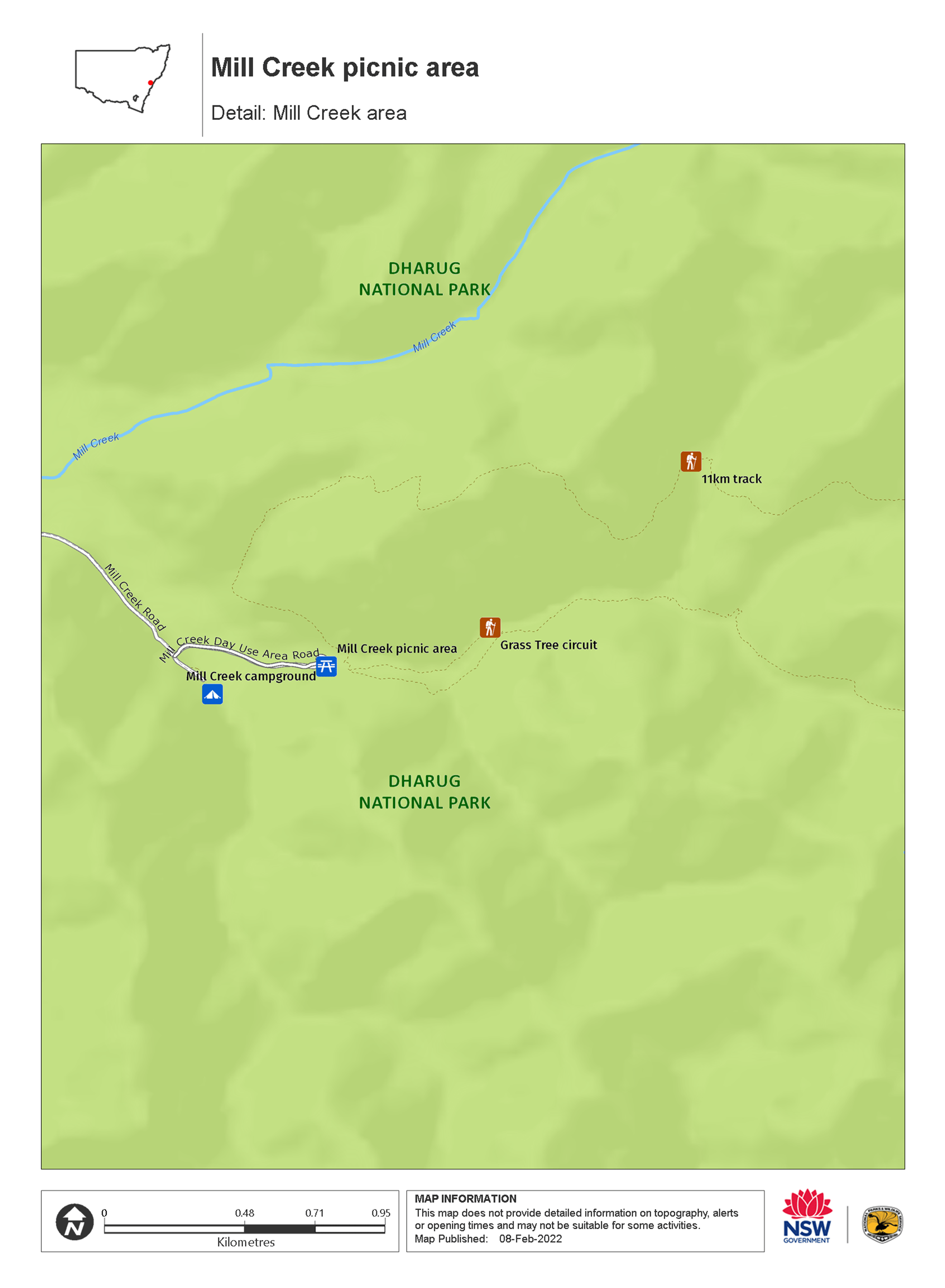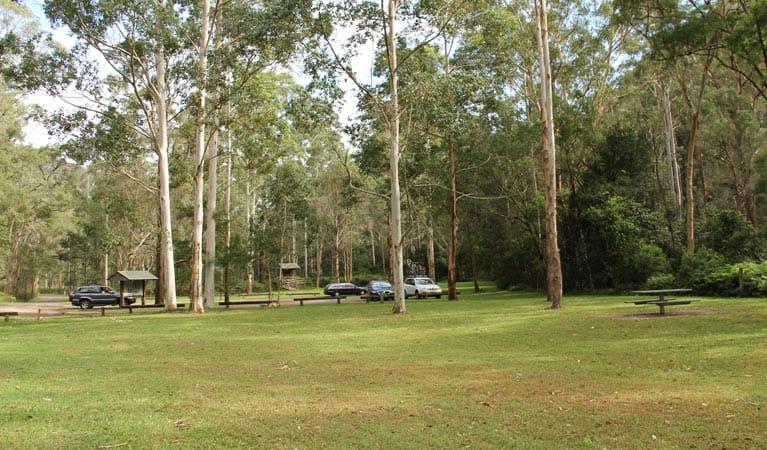Mill Creek picnic area
Dharug National Park
Overview
Enjoy a family picnic at Mill Creek picnic area in Dharug National Park. There’s plenty of space for a barbecue, plus there’s easy access to walking and bike tracks.
- Type
- Picnic areas
- Where
- 174 Mill Creek Road, Gunderman, NSW, 2775 - in Dharug National Park in Sydney and surrounds
- Accessibility
- Easy
This lovely grassy picnic area is the perfect place to stop to enjoy the peace and beauty of Dharug National Park.
Set up your picnic at one of the tables, there are wood barbecues available at the adjacent campground if you’d like to cook. When you’ve polished off a tasty feast, stretch out under the canopy and listen to the bellbirds and kookaburras while the kids have a run around or if you’re feeling energetic, set off on the Grass Tree circuit. If you’re interested in Australian history, set off on foot or on your bike along the Devines Hill loop to explore the World Heritage-listed convict-built Old Great North Road.
Map

Map legend

Local alerts
For the latest updates on fires, closures and other alerts in this area, see https://www.nationalparks.nsw.gov.au/things-to-do/picnic-areas/mill-creek-picnic-area/local-alerts
General enquiries
- National Parks Contact Centre
- 7am to 7pm daily
- 1300 072 757 (13000 PARKS) for the cost of a local call within Australia excluding mobiles
- parks.info@environment.nsw.gov.au
Park info
- in Dharug National Park in the Sydney and surrounds region
Dharug National Park is always open but may have to close at times due to poor weather or fire danger.
Visitor info
All the practical information you need to know about the Mill Creek picnic area.
Getting there and parking
Mill Creek picnic area is located about 8km east of the Wisemans Ferry crossing, on the north side of the Hawkesbury river in Dharug National Park.
To get there, turn right from the ferry and follow signs for Dharug National Park – Mill Creek campground, turn left and follow the road for 2km to the end, where you’ll find the campground.
You can also reach the campground by taking Wisemans Ferry Road from the F3.
Road quality
- Sealed roads
Vehicle access
- 2WD vehicles
Weather restrictions
- All weather
Parking
Parking is available at Mill Creek picnic area in a bitumen carpark, including an accessible parking space that's next to the paved pathway that leads to the toilets.
The carpark is about 20m away from the picnic tables.
Best times to visit
There are lots of great things waiting for you in Dharug National Park. Here are some of the highlights.
Autumn
The water has warmed up nicely by late summer so autumn is great for kayaking and canoeing along the Hawkesbury river.
Spring
The spring months are perfect for enjoying more strenuous activities in the park, like the longer walks and mountain bike riding. It's also the perfect time to see wildflowers.
Winter
The park is still stunning in winter and walking on sunny days is very pleasant. It can be cold at night so bring warm gear if you're camping.
Weather, temperature and rainfall
Summer temperature
Average
13°C and 27°C
Highest recorded
42.9°C
Winter temperature
Average
8°C and 18°C
Lowest recorded
-0.1°C
Rainfall
Wettest month
February and March
Driest month
September
The area’s highest recorded rainfall in one day
230.2mm
Facilities
- Water is available for washing your hands, but it's not recommended for drinking. It’s a good idea to bring your own supply of drinking water.
- Please remember to take your rubbish with you upon leaving the park.
Toilets
- Non-flush toilets
Picnic tables
Barbecue facilities
There are 2 gas barbecues under a shelter at the picnic area.
- Gas/electric barbecues (free)
Step-free access
The picnic area is flat and step-free, with a paved footpath that leads from the carpark to the toilets.
To get to the picnic tables and other facilities you'll need to cross over flat grass.
- Step-free outdoor pathways
Seats and resting points
There are sandstone logs along the edge of the carpark where you can rest.
Maps and downloads
Accessibility
Disability access level - easy
Mill Creek picnic area is flat and step-free, with the following accessible facilities:
- 1 accessible parking space in a bitumen carpark
- Accessible toilets that are set along a paved path from the carpark. The toilets have a fibreglass reinforced walkway with handrails that leads to the entrance.
- Accessible picnic tables
- Sandstone logs near the carpark where you can rest
You'll need to cross over flat grass to reach some of the facilities.
Prohibited
Pets
Pets and domestic animals (other than certified assistance animals) are not permitted. Find out which regional parks allow dog walking and see the pets in parks policy for more information.
Smoking
NSW national parks are no smoking areas.
Learn more
Mill Creek picnic area is in Dharug National Park. Here are just some of the reasons why this park is special:
Aboriginal heritage

Dharug National Park is the traditional Country of the Dharug Aboriginal people. Abundant in animal, plant and bird life, the area was a rich source of food, medicines and shelter. The park's diverse landscapes and all they contain feature in all aspects of Aboriginal culture and are associated with Dreaming stories and cultural learning that is still passed on today.
Rugged beauty

From the rugged bushland containing gang-gang cockatoos, satin bowerbirds and Lewin's honeyeaters to the sparkling waters of the creeks and the rich colours of the sandstone cliffs and formations, Dharug National Park offers a diverse range of landscapes. Bring your bike, bushwalk, camp by the creek, canoe on the Hawkesbury or make the most of the backdrop with your camera, there is so much to explore.
Step into Australia’s past

Dharug National Park contains the Old Great North Road, one of 11 historic sites which form the Australian Convict Sites World Heritage property. It's a spectacular example of early colonial engineering and demonstrates the use of convict labour; up to 720 convicts - some in chains - worked on the road, which spanned 264km, connecting Sydney to the settlements of the Hunter Valley. Only 43km of the road remains relatively intact, running from Wisemans Ferry in the south to Mount Manning in the north and includes the oldest surviving stone bridges in mainland Australia. It makes a great walk to explore over two or three days or an exhilarating day's cycle.
- Devines Hill loop Head to Devines Hill loop in Dharug National Park, near Wisemans Ferry this weekend for a bike ride or walk along the historic World Heritage-listed Devines Hill loop.
- Old Great North Road - World Heritage walk Old Great North Road – World Heritage walk highlights a historic convict-built road with scenic river views, via Finchs Line, in Dharug National Park.
Plants and animals protected in this park
Animals
-

Superb lyrebird (Menura novaehollandiae)
With a complex mimicking call and an elaborate courtship dance to match, the superb lyrebird is one of the most spectacular Australian animals. A bird watching must-see, the superb lyrebird can be found in rainforests and wet woodlands across eastern NSW and Victoria.
-

Australian brush turkey (Alectura lathami)
The Australian brush turkey, also known as bush or scrub turkey, can be found in rainforests along eastern NSW. With a striking red head, blue-black plumage and booming call, these distinctive Australian birds are easy to spot while bird watching in several NSW national parks.
-

Bare-nosed wombat (Vombatus ursinus)
A large, squat marsupial, the Australian bare-nosed wombat is a burrowing mammal found in coastal forests and mountain ranges across NSW and Victoria. The only other remaining species of wombat in NSW, the endangered southern hairy-nosed wombat, was considered extinct until relatively recently.
-

Lace monitor (Varanus varius)
One of Australia’s largest lizards, the carnivorous tree-dwelling lace monitor, or tree goanna, can grow to 2m in length and is found in forests and coastal tablelands across eastern Australia. These Australian animals are typically dark blue in colour with whitish spots or blotches.
Plants
-

Gymea lily (Doryanthes excelsa)
The magnificent Gymea lily is one of the most unusual Australian native plants, found only along the coast and surrounding bushland of the Sydney Basin, from Newcastle to Wollongong. In spring this giant lily shoots out spectacular red flowers that can reach heights of 2-4m.

